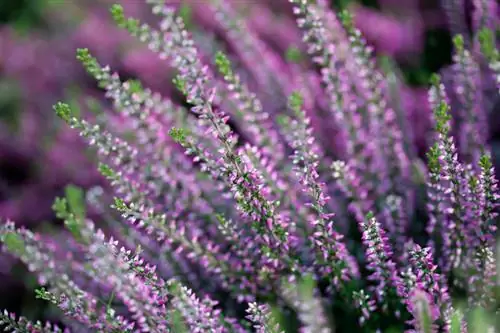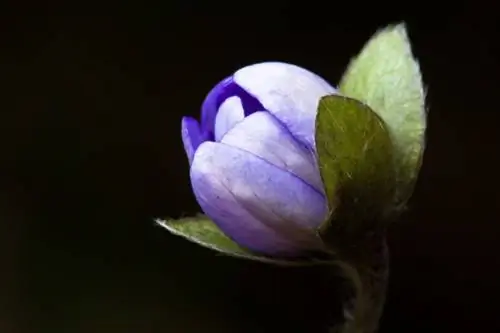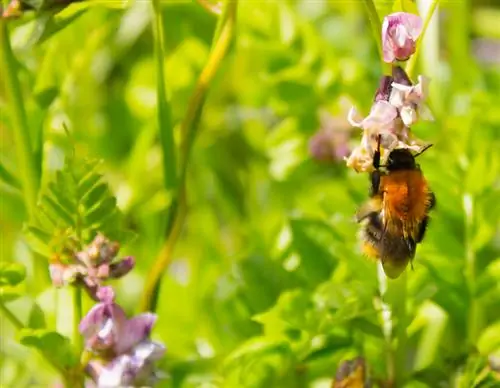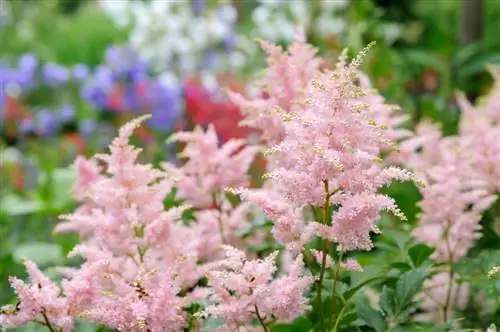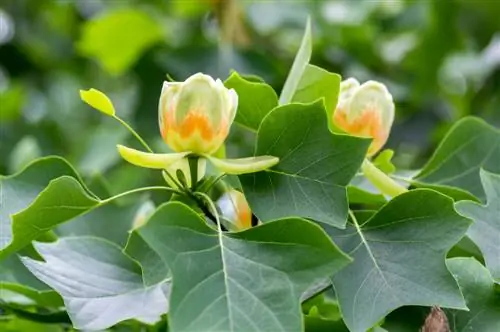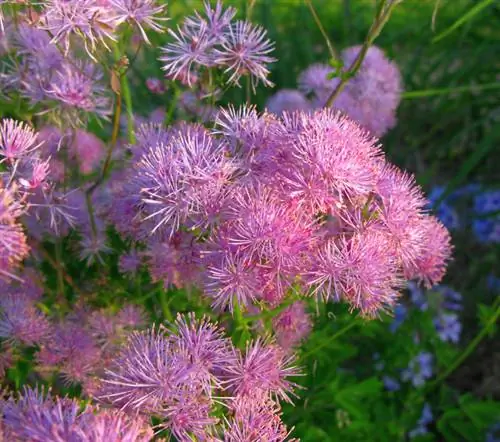- Author admin [email protected].
- Public 2023-12-25 17:45.
- Last modified 2025-01-23 11:22.
With heather, floral lushness moves into all garden regions that suffer from poor, acidic soil. Within the diverse genus, Calluna vulgaris has primarily captured our hearts. In summer, the evergreen heather sets off its white, pink or purple flower spikes and lasts until December. If you still have questions about cultivation on your mind, you can find informative answers here.
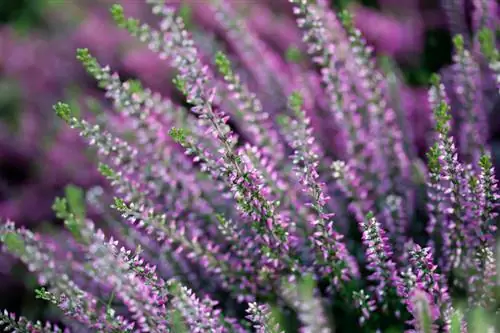
In which conditions does heather thrive best?
Heather (Calluna vulgaris) is an evergreen ornamental plant that blooms from August to December with white, pink or purple flower spikes. The plant prefers sunny to partially shaded locations with poor, loose and acidic soil.
Planting heather correctly
Plant heather in April/May or September/October in a sunny to partially shaded location. The soil there should be lean, loose, humic and acidic. Since a single Calluna vulgaris lacks expressiveness, we recommend planting in small tuffs with 3-5 specimens or in a wide arrangement as a ground cover. Therefore, create small planting holes at a distance of 20-30 cm in order to enrich the excavation with ericaceous soil or leaf compost. Meanwhile, the still potted root balls of the young heather herbs are allowed to drink their fill in soft water. Place the potted dwarf shrubs in the middle of the planting pit and fill the cavity with substrate to just below the lower leaves. After watering with soft water, we recommend spreading a layer of mulch made of autumn leaves or pine needles.read more
Care tips
The professional care program for a common heather is based on a balanced water balance, because a Calluna vulgaris rarely compensates for drought stress. All other aspects of successful cultivation follow this. How to do it right:
- Water heather with lime-free water as soon as the soil has dried
- Fertilize in March/April with acidic leaf or needle compost
- Give the pot a liquid fertilizer every 4-6 weeks from April to August
- Slight pruning of last year's shoots by half in March/April
While light winter protection only makes sense in the bed in the year of planting, common heather in pots should be protected from the rigors of winter every year. Wrap planters with foil or jute and cover the substrate with autumn leaves. Continue watering to prevent the root ball from drying out.read more
Which location is suitable?
Broom heather is undemanding when it comes to light and temperature conditions. Things are more specific when the focus is on the soil conditions at the location. We have put together all the relevant criteria for you here:
- Sunny to semi-shady location
- Air-surrounded and without summer heat
- Low-nutrient, humus-loose soil with good drainage
- Lime-free and acidic with a pH value of 4.5 to 5.5
Broom heather likes to associate with other plants that prefer acidic soil, such as conifers, rhododendrons and ornamental grasses.read more
What soil does the plant need?
You experience common heather in its most beautiful form when the soil is lean, fresh-moist and acidic in structure. A pH value of 4.5 to 5.5 is just right for Calluna vulgaris varieties, because the ornamental shrubs don't want to have anything to do with lime. An uncomplicated test from the garden center clears up all doubts, unless there are already typical indicator plants on site, such as pansies, daisies, ornamental grasses or speedwell.
What is the best time to plant?
Broom heather grown in a container can be planted at any time. However, avoid times when there is a summer drought or the ground is already frozen. Calluna vulgaris receives the best starting conditions for a long plant life when planting takes place in autumn. The roots establish themselves particularly quickly in sun-warmed soil.
When is flowering time?
The flowering period of Calluna vulgaris usually extends from August to November. Thanks to innovative new breeds, there are magnificent hybrids to choose from that delight us with their blooms from July to December. As a rule of thumb, varieties with single flowers show more stamina than heather with double flowers. Cut back the small ornamental shrubs in spring to make room for the next flower festival.read more
cutting heather correctly
Broom heather is characterized by its lush branches and leisurely growth. To maintain flowering and vitality, we recommend annual pruning. The best time for this important care measure is an overcast, frost-free day in March or April. How to do it right:
- Cut off the previous year's growth by half with secateurs
- Do not cut into old wood, as Calluna vulgaris has difficulty growing again from it
- At the same time, thin out the entire small shrub thoroughly
- Remove dead wood close to the ground as well as stunted and inward-facing branches
After a very mild winter, move the date forward to February, as premature new growth is to be expected.read more
Watering heather
If broom heather is subjected to drought stress, the ornamental shrub reacts by watering down. Within a few days all the flowers and leaves sadly fall to the ground. To prevent this from happening, water Calluna vulgaris regularly when the soil surface is dry. In the best case scenario, use decalcified tap water, collected rainwater or pond water. With the help of a layer of mulch you can reduce the need for watering, as leaves, pine needles or bark mulch keep the soil moist for longer.
Fertilize heather properly
Besenheide is satisfied with an organic starter fertilization in spring. Ideally, add acidic leaf or coniferous compost to the roots. If you water regularly with nutrient-rich pond water, there is no need to add fertilizer. A mulch layer of leaves or pine needles prevents deficiency symptoms from occurring in the first place. If a Calluna vulgaris thrives in a pot or balcony box, add a liquid fertilizer to the substrate every 4-6 weeks.
Wintering
Broom heather is one of the hardy heather plants. Frosty temperatures, especially in the bed, have no effect on the permanent autumn bloomer. Winter drought is more dangerous than low temperatures below zero. If there is no snow or rain, water with lime-free water on mild days. In the year of planting, we recommend a mulch layer of leaves and pine needles, as young Calluna vulgaris have not yet fully developed their winter hardiness.
Propagate heather
The many advantages of common heather include the numerous propagation methods. There is a suitable approach for every hobby gardener:
- Cut half-woody cuttings in summer and let them root in pots with potting soil
- In spring, pull flexible branches to the ground, bury in the middle and cut off when a root system has formed
- Dig up the root ball in autumn, divide it and place it in the ground at the new location
Sowing broom heather, on the other hand, is laborious and time-consuming. Since these are light and cold germinators, it will take 2-3 years before you can enjoy the first flowering.read more
How do I transplant correctly?
Besenheide accepts a change of location without hesitation. Dig up the root ball in fall or spring. In the new place, place the dwarf shrub in loose, humus-rich and acidic soil. If possible, stick to the existing planting depth and water with soft water. If you enrich the excavation with leaf compost or ericaceous soil, this measure will have a revitalizing effect on further growth.
Heather in a pot
In pots, common heather creates autumnal cheer on balconies and terraces in a sunny to partially shaded location. We recommend rhododendron soil enriched with lava granules or expanded clay as a substrate. Cover the water drain in the floor with a piece of pottery as an effective prophylactic against waterlogging. This is how you properly care for the distinctive Calluna vulgaris:
- Keep the substrate constantly slightly moist
- Watering preferably with soft water
- Fertilize liquidly every 4-6 weeks from March to August
- Cut last year's growth by half in March/April
The heather plant is well hardy. We still recommend covering the pot with bubble wrap or colorful jute ribbons. Do not let the dwarf shrub dry out during the winter and water it with lime-free water every now and then.
Is heather poisonous?
You won't find common heather on the list of poisonous plants. In fact, the legendary herbalist Sebastian Kneipp valued the effective ingredients for healing various ailments with natural remedies. Prepared as an infusion, flowers and leaves relieve diseases of the urinary and respiratory tract. Applied externally, heather helps against all kinds of skin irritations. We also have Calluna vulgaris to thank for its unique heather honey, as the flowering plant is a much-loved pasture for bees.read more
Brown leaves
Brown leaves on a heather put the experienced hobby gardener on high alert because the ornamental tree is obviously suffering from drought stress. As a rule, this damage is accompanied by a trickle. Immediately water generously with soft water without causing waterlogging. Place Calluna vulgaris in the pot with the root ball in lime-free water until no more air bubbles appear.
Yellow leaves
If the shiny green leaves of evergreen heather turn yellow, this symptom indicates an excess of lime in the soil. In this context, the pH value increases, which blocks the absorption of important nutrients. Switch the water supply to collected rainwater or decalcified tap water. In the advanced stage, fertilize briefly with an iron preparation (€56.00 on Amazon) to compensate for the deficiency.
Beautiful varieties
- Brina: Noble summer heather with ruby-red, double flowers for heather gardens, pots and balcony boxes; Growth height 10-30 cm
- Boskoop: Common heather with purple flowers over golden yellow foliage; a feast for the eyes in every season; Growth height 20-30 cm
- Westerlee Gold: White-flowering Calluna vulgaris from September to October with golden yellow leaves; Growth height 20-30 cm
- Angie: The variety scores with a long flowering period in light red flowers from August to November; Growth height 20-30 cm
- Rosita: The little jewel blooms in pure pink from October to December in beds and containers; Growth height 10-20 cm
- Beoley Silver: Premium variety that highlights the white flowers with shimmering silver foliage; Growth height 30-35 cm

